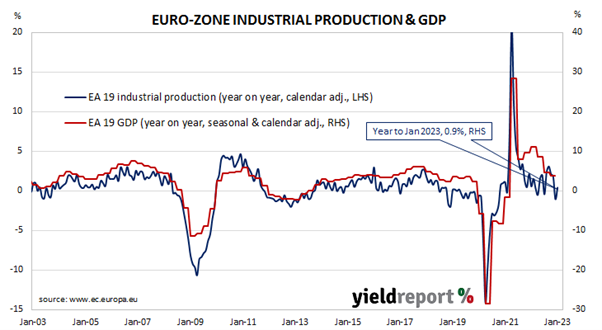Summary: Euro-zone industrial production up 0.7% in January, rise more than expected; annual growth rate accelerates from -2.1% to +0.9%; German, French 10-year yields drop on banking news; German output expands, contracts in France, Spain, Italy.
Following a recession in 2009/2010 and the debt-crisis which flowed from it, euro-zone industrial production recovered and then reached a peak four years later in 2016. Growth rates then fluctuated for two years before beginning a steady and persistent slowdown from the start of 2018. That decline was transformed into a plunge in March and April of 2020 which then took over a year to claw back. Production levels in more-recent months have generally stagnated in trend terms.
According to the latest figures released by Eurostat, euro-zone industrial production expanded by 0.7% in January on a seasonally-adjusted and calendar-adjusted basis. The result was more than the 0.3% expansion which had been generally expected and in contrast with December’s 1.3% contraction after revisions. The calendar-adjusted growth rate on an annual basis accelerated from December’s revised rate of -2.1% to +0.9%.
German and French sovereign bond yields dropped on the day following news of a major European bank seeking assistance from the Swiss National Bank. By the close of business, the German 10-year bund yield had shed 27bps to 2.18% while the French 10-year OAT yield finished 23bps lower at 2.73%.
Industrial production expanded in the euro-zone’s largest economy, Germany, but contracted in the other three of the euro-zone’s four largest economies. Germany’s production increased by 1.8% over the month while the comparable figures for France, Spain and Italy were -2.9%, -0.9% and -0.7% respectively.


